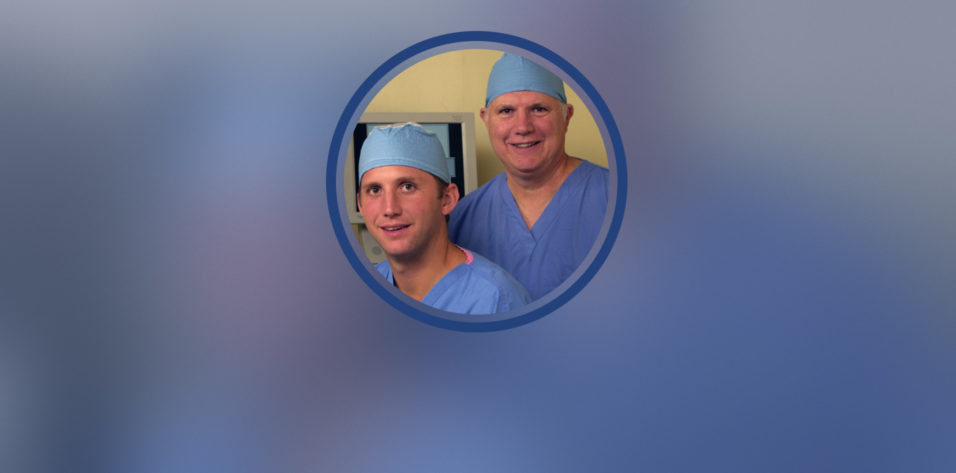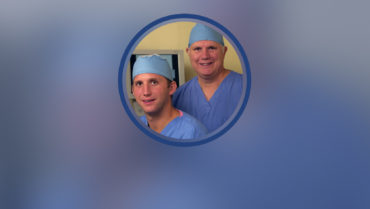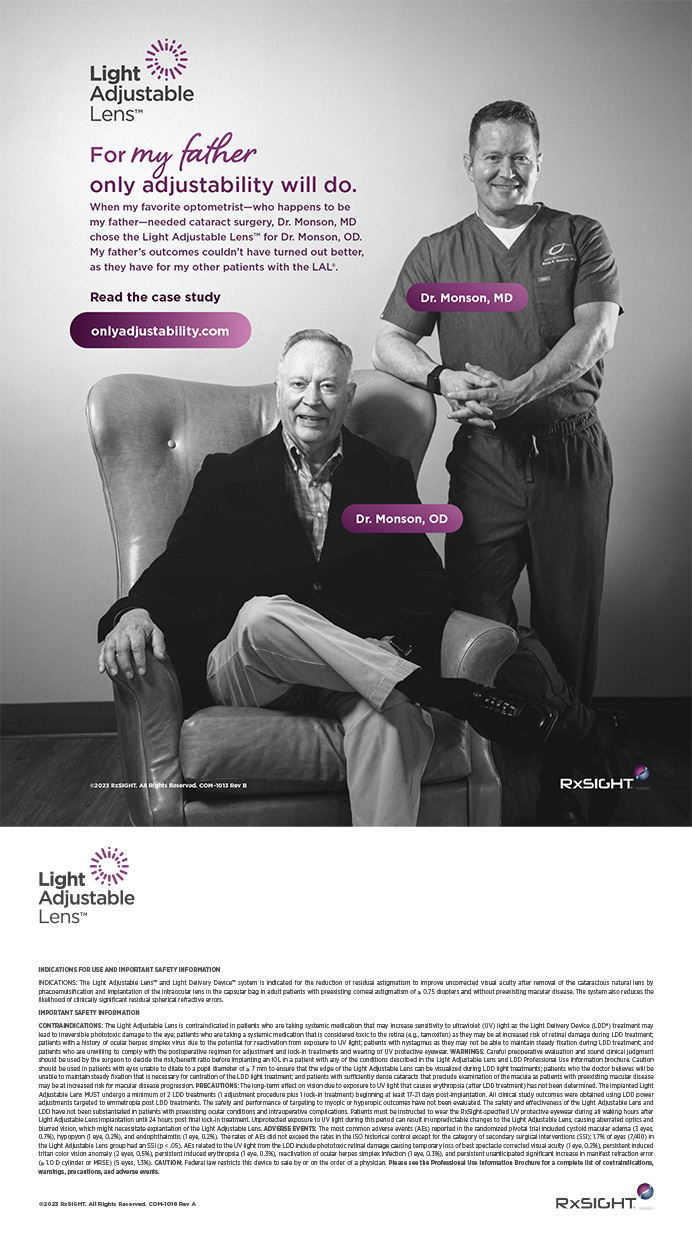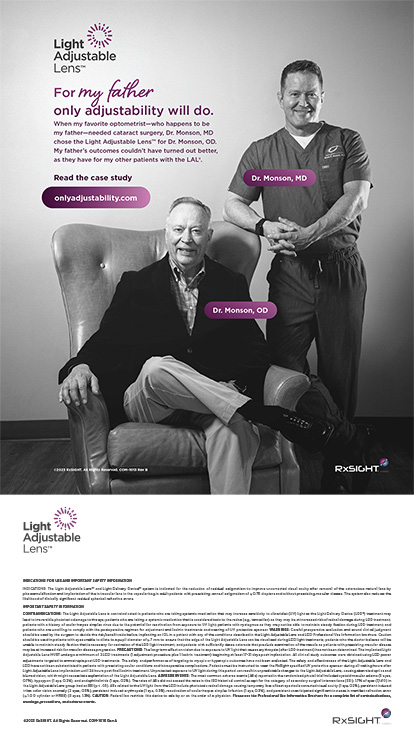A Treadmill of Work
By Robert G. Wiley, MD
It was a life-saver for me that my son Bill chose ophthalmology and joined me in practice. In 2003, at the age of 32, Bill finished his residency in ophthalmology at Rush University Medical Center in Chicago. I was 59 years old and had some health issues. At that time, I was on a treadmill of work, and I could not seem to get off. Bill’s joining the practice as a senior partner in 2003 allowed me to begin a transition toward retirement almost immediately. It was a quick transition. I practiced with Bill for only 6 months, so he had to hit the ground running.
When Bill joined the practice, I repeated to him wisdom that I had received from my father, a Court of Appeals judge in Ohio, when I first started practice. After I had been in practice for a year, my father said, Bob Wiley will generally be replaced by Robert G. Wiley, MD. After 20 years, it will become Dr. Wiley. After 30 years, it might eventually turn into just Doctor. It is not planned; it just happens. Bill’s joining my practice allowed the rebirth of Bob Wiley and the reemergence of dad as well as a new role, grandpa.
GOOD WORK ETHIC
When Bill was young, it was important to him to play competitive sports. He had good coaches, and his time on the soccer field and in the hockey rink (Figure 1) prepared him well for his later academic and professional journey. Of equal importance to competitive sports, Bill and his brothers and sister developed a good work ethic. On weekends, when we went to the family farm, Bill never shied away from the work. Driving the tractor (Figure 2), cutting grass, and digging up carrots and potatoes were jobs he knew he had to do before he could go running in the woods with his siblings.

Figure 1. As a child, Bill enjoyed playing ice hockey.
During the 6 months that I stayed in the practice with Bill, I was more relaxed and was able to spend more time with my wife, Donna. She and I have been happily married for 49 years, and Bill has been blessed with many of her fine qualities, among them patience and tolerance.
Bill respectfully listened and learned everything he could from me in those 6 months, and we got along fine. The staff and referring doctors loved him. It was obvious from the start that Bill had what surgeons call good hands and a superb OR temperament.
A HEAVY ROLE
Bill respected my decision to retire, which I knew was the right one. I did not want to be Bill’s boss. I had been senior partner in the practice long enough; the weight of that senior role was getting heavy. I knew that, if I stepped aside, the patients, referring doctors, and staff would quickly shift their respect and allegiance to Bill.
Within a short period, the legal work was agreed upon, and Bill bought the practice. The staff had always looked to me as the leader and boss, and it took time for them and for Bill to transition into their new roles. Initially, if the staff did not like a new policy position that Bill wanted to put into place, they might come to me to see if I would overrule Bill’s decision. I quickly and with authority stated that Bill’s way was the right way. It did not take long for the staff to understand that Bill was now the boss.
Bill was respectful of my opinions, which made for a comfortable transition. Occasionally (fortunately not often), I had to force myself to take a back seat when I felt that Bill might have been making an incorrect policy decision, or if he were considering buying an expensive piece of equipment that I did not think would be useful. I might sheepishly offer an opinion but would not challenge him: after all, it was his practice and his money.
BECOMING AN EARLY ADOPTER
I have been proud to see Bill grow into his role and become an early adopter of beneficial technologies. After I had been retired from the practice for some time, I went to visit, and it made me proud to see Bill’s new office and ambulatory surgery center. He showed me the ORA System with VerifEye+ Technology (Alcon) and a stack of charts for his first 25 patients who had undergone ORA-assisted surgery. While Bill drove us home that day, I reviewed the charts and made mental notes concerning his statistical success. Within 15 minutes, I had determined that the ORA allowed him to make IOL changes in real time in about a third of his cases. His patients’ postoperative visual acuity results, I thought, were unbelievably good.
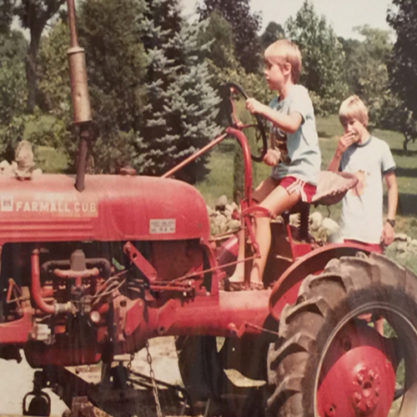
Figure 2. Bill and his brother on their father’s farm.
I told Bill that his colleagues might not believe that intraoperative aberrometry-assisted surgery could produce such good intraoperative information and such excellent postoperative refractive accuracy and that there might be resistance to this technology. It reminded me, I said, that there had been significant resistance to the initial acceptance of phacoemulsification, outpatient cataract surgery, radial keratotomy (RK), PRK, and LASIK in my earlier days. It made me proud, I told him, that he was one of the early adopters of this new technology.
Over the years, we have shared many father-son discussions about ophthalmology that produced great joy for us both. For example, I told Bill that, when I first heard about RK, I was sure it was not true that Russian ophthalmologist Svyatoslav Fyodorov, MD, was cutting the cornea with a razor blade chip. (After all, in 1975, we did not trust much of what came out of the Soviet Union.) When I found out that it was true, I still was sure that it was not a good idea. How could cutting a perfectly healthy cornea with a razor blade chip be good for the cornea? A couple of years later, however, I found myself doing and teaching RK. It was not foreign or new any longer.
That episode reminds me of a couple of relevant quotations:
“All new doctrine goes through three stages. It is attacked and declared absurd; then it is admitted as true and obvious but insignificant. Finally, its true importance is recognized and its adversaries claim the honor of having discovered it.”
– William James
“It ain’t what you don’t know that gets you into trouble. It’s what you know for sure that just ain’t so.”
– Mark Twain
PHASING OUT Dr. BOB
My ophthalmology career, spanning 27 years, was stimulating and exciting: You might say that I was in the right place at the right time. However, in 2003, it was time for Dr. Bob to phase out. Thankfully, Bill, with fresh strong legs, was there to take the baton. For the past 13 years of retirement, I have enjoyed returning to being Bob Wiley. Although there was much joy in being a respected colleague of my son, at my age of 72, it is much better being father, granddad, and full-time husband.
Oh, one more proud moment: Bill performed cataract surgery on his mother using ORA-guided imaging. She could not be happier with her excellent postoperative vision.
Riding the Coattails of a Strong Family Name
By William F. Wiley, MD
Growing up in a household with an innovative father during innovative times was exciting, as it showed me the potential of what medicine had to offer to forward-thinking individuals. During the late 1980s and the 1990s, ophthalmology was beginning a renaissance of techniques and technologies. My father was one of the pioneers of the time. He helped to work through the early days of conversion from inpatient to outpatient cataract surgery. During this time, cataract surgery was transforming quickly from intracapsular to extracapsular cataract extraction and then to phacoemulsification and from the need for multiple stitches ultimately to no-stitch surgery.
This progress was not without controversy. Established ophthalmology resisted change and openly discouraged progress. Opinion leaders at traditional meetings wore badges declaring “Not My Colleagues,” describing their discontent with phacoemulsification’s pioneers. This led to the birth of alternative societies such as the Society for Excellence in Eyecare (SEE), which welcomed and encouraged change and provided a place where physicians like my father flourished.
INTRODUCING THE WEST TO RK
In addition to witnessing the tumultuous transformation of cataract surgery as a child, I also saw firsthand the birth of refractive surgery. Alongside my father, I watched the episode of 60 Minutes that introduced the West to RK in the Soviet Union, and I observed his early skepticism. The general thought at the time was that this could not be true, that it was not possible to correct myopia with surgery, or if true, it had to be dangerous, with risk of vision loss. That said, I was then able to witness my father’s journey from disbelief to acceptance to proficiency in the technique. (I ultimately became an RK patient, and I have had more than 20 years of spectacle independence.)

Figure 3. Bob (left) and Bill (right) at Bill’s commencement ceremony.
Years later, I was able to travel to Russia for a medical school externship and to work briefly with Dr. Fyodorov. I witnessed firsthand the conveyor belt surgery that Dr. Fyodorov made famous. The individual surgical maneuvers for RK and cataract surgery were standardized and performed by technicians. Dr. Fyodorov’s clinic was a high-volume surgical facility, producing excellent results for both RK and cataract surgery.
CONTAGIOUS EXCITEMENT
The environment of innovation in cataract surgery and the birth of the field of refractive surgery was contagious to me as a child. I was influenced by the constant excitement and was able to observe the progress, innovation, and collegial sharing of ideas that took place among the practitioners in these fields. Family vacations were planned around an annual trip to the Caribbean, where my father and like-minded colleagues discussed ways to improve their practices and techniques. These small gatherings ultimately led to a collaboration with SEE and the America College of Eye Surgeons (ACES), which, to this day, holds an annual meeting featuring worldwide opinion leaders who freely discuss, formally and informally, new techniques and issues of the day.
The idea of traveling to gain knowledge was ingrained in me. Growing up in the small Midwestern town of Toledo, Ohio, theoretically imposed limits on innovation, but my father impressed upon me that access to the world’s most innovative techniques was just a plane trip away. I traveled with my dad to multiple countries, including China and Taiwan, to witness firsthand technologies not yet available in the United States.
After my residency, the decision to join my father’s practice was relatively easy (Figure 3). He had built the foundation of a strong cataract and refractive practice with opportunity for geographic growth and scope-of-practice expansion. My father was selfless in his pursuit of training me in refractive surgery during my first year of practice.
THE WILEY TEAM
Given the option, few patients would have chosen me over my father to perform their self-pay refractive surgery. With this in mind, my father decided to promote LASIK surgery by The Wiley Team. “Dr. Wiley Senior will run the laser, while Dr. Wiley Junior will work the keratome.” My father became the laser technician and ran the excimer laser while I performed the technical aspects of the surgery. This allowed me to quickly learn LASIK, while providing a comfortable perception to patients, as both of us were present.
After feeling that he had passed most of his surgical knowledge on to me, my dad retired relatively early after I joined him. This had both negatives and positives for my early practice experience. To fill the void he left, I became a high-volume surgeon relatively quickly, which helped tremendously in building my surgical experience and skill set, but this also added to the pressure and stress of running a large practice myself relatively early in my career.
Although my father retired early, he continued to guide me with strong encouragement toward continued leading-edge innovation in refractive surgery and advanced cataract surgery, with a goal of revenue streams of about 50% private pay and 50% insurance and government payments.
writing A PERSONAL CHECK
When the Crystalens (Eyeonics, now Bausch + Lomb) technology was launched, it was the first time the Centers for Medicare Medicaid Services allowed surgeons to bill patients outside of the Medicare reimbursement structure of the time. There was no established path for Medicare recipients to purchase and Medicare providers to provide the expensive technology. At the launch meeting for the Crystalens, I was worried about the expensive hurdle of entry, which required the purchase of 20 lenses at a price of $1,000 each. What patient was going to buy this? Who could afford to buy the lenses in bulk in advance like this?
My dad, who was also at the meeting, pulled out his checkbook, wrote a personal check, and handed it to Andy Corley, the chief executive officer of Eyeonics. My father assured me, “Trust me. You want to be involved in this technology. This initial hurdle is a small price to pay for you and your practice to help innovate this for your current and future patient base.”
A MULTIGENERATIONAL PRESENCE
Joining a legacy practice allowed a natural succession of goodwill. It is hard to deny the local value of a multigenerational presence. I recognized the value, and I purchased the practice from my father—although, not surprisingly, we each had strong opinions on what was actually a fair price.
Word of mouth is crucial in the field of elective cataract and refractive surgery, and therefore, having the ability to ride the coattails of a strong family name has proved to be most valuable to me.
As the practice continues to grow, I cannot help but wonder if I am laying the foundation for future Wiley generations. Will my excitement with the field of ophthalmology be as contagious to my children as my father’s was to me? One can only hope.

